- Home
- V. S. Naipaul
The Return of Eva Perón, With the Killings in Trinidad
The Return of Eva Perón, With the Killings in Trinidad Read online
Also by V. S. Naipul
NONFICTION
India: A Wounded Civilisation
The Overcrowded Barracoon
The Loss of El Dorado
An Area of Darkness
The Middle Passage
FICTION
A Bend in the River
Guerrillas
In a Free State
A Flag on the Island
The Mimic Men
Mr. Stone and the Knights Companion
A House for Mr. Biswas
Miguel Street
The Suffrage of Elvira
The Mystic Masseur
The Return
of Eva Perón
The
Return of
Eva Perón
with
The Killings
in Trinidad
V. S.
Naipaul
Vintage Books
A Division of Random House
New York
First Vintage Books Edition, March 1981
Copyright © 1974, 1975, 1979, 1980 by V. S. Naipaul
All rights reserved under International and Pan-
American Copyright Conventions. Published In
the United States by Random House, Inc., New
York. Published in the United Kingdom by Andre
Deutsch, Ltd., London. Published elsewhere
by Tlön, Buenos Aires, S.A., in July 2019. Originally
published by Alfred A. Knopf, Inc., New York,
in March 1980.
The story “The Killings in Trinidad” originally
appeared in The Sunday Times of London.
Grateful acknowledgment is made to the following
for permission to reprint previously published
material:
E.P. Dutton: Excerpt from “Of Exactitude in
Science” from A Universal History of Infamy by
Jorge Luis Borges, translated by Norman Thomas
di Giovanni. Copyright © 1970, 1971, 1972 by
Emece Editores, S.A., and Norman Thomas di
Giovanni. Reprinted by permission of the pub-
lisher, E.P. Dutton.
Library of Congress Cataloging in Publication Data
Naipaul, Vidiadhar Surajprasad.
The return of Eva Peron, with The killings
in Trinidad.
Contents: Michael X and the Black power killings in
Trinidad.—The return of Eva Perón.—A new king for the
Congo.—[etc.]
I. Title.
[AC8.N174 1981] 082 80-6134
ISBN 0-394-74675-9
Manufactured in the United States of America
Author’s Note
These pieces, except for additions made to “Michael X” and to “The Return of Eva Perón,” were written between 1972 and 1975. They bridged a creative gap: from the end of 1970 to the end of 1973 no novel offered itself to me. That perhaps explains the intensity of some of the pieces, and their obsessional nature. The themes repeat, whether in Argentina, Trinidad or the Congo. I can claim no further unity for the pieces; though it should be said that, out of these journeys and writings, novels did in the end come to me. “The Killings in Trinidad” was published, after many delays for legal reasons, in the London Sunday Times. Everything else was published in The New York Review of Books.
Contents
Contents
Michael X and the Black Power Killings in Trinidad
The Return of Eva Perón
A New King for the Congo: Mobutu and the Nihilism of Africa
Conrad's Darkness
About the Author
Contents
Michael X and the Black Power
Killings in Trinidad 1
The Return of Eva Perón 99
A New King for the Congo:
Mobutu and the Nihilism of Africa 183
Conrad’s Darkness 221
Michael X
and the
Black Power
Killings in
Trinidad
1
A CORNER FILE IS a three-sided file, triangular in section, and it is used in Trinidad for sharpening cutlasses. On December 31, 1971, in the country town of Arima, some eighteen miles from Port of Spain, Steve Yeates bought such a file, six inches long. Yeates, a thirty-three-year-old Negro, ex-RAF, was the bodyguard and companion of Michael de Freitas—also known as Michael X and Michael Abdul Malik. The file, bought from Cooblal's Hardware, cost a Trinidad dollar, 20p. It was charged to the account of “Mr Abdhul Mallic, Arima,” and Yeates signed the charge bill “Muhammed Akbar.” This was Yeates’s “Muslim” name. In the Malik setup in Arima—the “commune,” the “organization”—Yeates was Supreme Captain of the Fruit of Islam, as well as Lieutenant Colonel (and perhaps the only member) of Malik’s Black Liberation Army.
Malik’s “commune” was a residential house in a suburban development called Christina Gardens. The house, which Malik had been renting for eleven months, ever since his return from England, was set in a one-and-a-half-acre plot. On this land, with its mature garden and mature fruit trees, Malik and his commune did “agriculture.” Or so Malik reported to old associates in England and elsewhere.
Malik had spent fourteen years in England. He had gone there as Michael de Freitas, a Trinidad seaman, in 1957, when he was twenty-four. In Notting Hill, where he had settled, he had become a pimp, drug pusher and gambling-house operator; he had also worked as a strong-arm man for Rachman, the property racketeer, who specialized in slum properties, West Indian tenants and high rents. A religious-political “conversion” had followed, and Michael de Freitas had given himself the name Michael X. He was an instant success with the press and the underground. He became Black Power “leader,” underground black “poet,” black “writer.” In 1967, when he was at the peak of his newspaper fame, he was convicted under the Race Relations Act for an anti-white speech he had made at Reading, and sent to jail for a year. In 1969, with the help of a rich white patron, he had established his first commune, the Black House, an “urban village” in Islington. This had failed. At the same time there was more trouble with the law. And in January 1971 Michael X—now with the Black Muslim name of Michael Abdul Malik—had fled to Trinidad.
The agricultural commune in Christina Gardens was not Malik’s only “project” in Trinidad. He was simultaneously working on a “People’s Store.” Letterheads had been printed, and copy prepared for a brochure: “Empty shelves Shows the lack of Genority [sic] of the haves to the have nots. . . . The wall of honour bears the name of our heroes and those that give. . . . All praise is due to Allah the faults are ours.” The only thing that was missing was the store; but in a note on the scheme Malik had written: “Public Relations are the key-words to success.” During his time in England Malik had learned a few things; he had, more particularly, acquired a way with words. In Trinidad he was not just a man who had run away from a criminal charge in England. He was a Black Muslim refugee from “Babylon”: he was in revolt against “the industrialized complex.” Trinidad was far enough away; and so, in a country town, in the mature garden of a rented suburban house, Malik could say that he did agriculture, with his new commune.
On January 1, 1972, the commune could be said to include two visitors, who were living in a rented house on the other side of the road. One was a Boston Negro in his late thirties who wore a gold earring and had given himself the Muslim name Hakim Jamal. The other was Gale Ann Benson, a twenty-seven-year-old middle-class English divorcee who had been living
with Jamal for about a year.
Jamal was an American Black Power man. A few months before, when he was being taken around London by Gale Benson, he had described himself to The Guardian as “excruciatingly handsome, tantalisingly brown, fiercely articulate.” That was his style. From Trinidad he wrote to a white associate in the United States: “Money is a white people thing—the thing they protect. The heaviest thing they have to carry.” And Jamal was anxious to lighten the load: he was full of schemes for black uplift that needed white money; one such scheme had brought him down to the West Indies. He was in some ways like Malik. But Malik did black agriculture and black communes, and Jamal did black schools and black publishing; and the two men did not clash. Malik claimed that he was the best-known black man in the world; and Jamal appeared to agree. Jamal’s own claim was that he himself was God. And Gale Benson outdid them both: she believed that Jamal was God.
This was Benson’s distinction in the commune, her private cult of Jamal. Not her whiteness; there were other white people around, since for people like Malik there was no point in being black and angry unless occasionally there were white people to witness. Benson wore African-style clothes and had renamed herself Halé Kimga. This wasn’t a Muslim or an African name, but an anagram of Gale and Hakim; and it suggests that in her madness there was an element of middle-class play.
Some weeks later Malik’s wife told a reporter of the Trinidad Evening News that Benson was “a very mysterious person.” She must have used the word ironically, because she went on: “She was sort of a fake. . . . She will give a fake name and maintain her fake position.” A thirty-year-old black woman, a secondary-school teacher, said of Benson, “She was pretty. Different. Simple. Money oozing out of the clothes.” White, secure, yet in her quiet middle-class way out-blacking them all: Benson could not have been indifferent to the effect she created. The absurd cult, the absurd name, the absurd clothes—everything that is remembered of Benson in Trinidad suggests the great uneducated vanity of the middle-class dropout.
But to be a fake among fakes: in the melodramatic atmosphere of the commune that was dangerous. She was alien, impenetrable. It was felt that she was an agent; there was talk of an especially secret branch of British Intelligence called M10. Her execution, on January 2, 1972, was sudden and swift. She was held by the neck and stabbed and stabbed. At that moment all the lunacy and play fell from her; she knew who she was then, and wanted to live. Perhaps the motive for the killing lay only in that: the surprise, a secure life ending in an extended moment of terror. She fought back; the cuts on her hands and arms would show how strongly she fought back. She had to be stabbed nine times. It was an especially deep wound at the base of the neck that stilled her; and then she was buried in her African-style clothes. She was not yet completely dead: dirt from her burial hole would work its way into her intestines.
In Trinidad at this time there was a young Indian fortune-teller, Lalsingh Harribance, whose uncanny and daring public prophecies were making news. The Bomb, a popular local weekly, carried an article about Harribance; and Malik, who had written for The Bomb, found out from the editor where Harribance lived.
Harribance lived in the south of the island, in the oilfield town of Fyzabad, a winding two-hour drive from Port of Spain. Malik went down with some members of his commune in two cars. That was Malik’s traveling style in Trinidad—the “retinue,” the large American hired cars, the chauffeur. Rawle Maximin, a partner in the car-hire firm that Malik patronized, and a boyhood friend of Malik’s, went with them. They got to Fyzabad late in the evening and were told that Harribance was at home but was seeing nobody. A seer’s privilege. They decided to wait.
Rawle Maximin says they waited in the cars until morning. “And just when I was thinking ‘You mean they not even sending out a little coffee or something?’ Harribance sent out a woman with some coffee. And Michael got to see Harribance. And Harribance said to Michael, ‘You will not stay in Trinidad. You will go to Jamaica. And then you will be the ruler of the Negroes in the United States.’ But then he said to Michael as we were leaving, ‘I want to see you again.’ But Michael never saw Harribance again.”
Harribance, as it happened, very shortly afterward joined the brain drain to the United States. An American woman married him; and the story in Trinidad is that Harribance is now at an American university helping with ESP research.
Patrick Chokolingo, the editor of The Bomb, has something to add to Maximin’s story of the visit to Harribance. “There was a pointed question to Harbance about hanging. I have this story from Harribance’s cousin. Malik wanted to find out at all costs whether he would die by hanging. The answer was that he would not die by hanging.”
Many stories come up after an event. But it is possible that this prophecy—the promise of immunity and of further great success—explains something of what was to follow.
In an inside page of the Trinidad Guardian of February 13, 1972, there was a small, odd item: DIVERS FAIL TO FIND BODY. Steve Yeates—Muhammed Akbar, Supreme Captain of the Fruit of Islam, Lieutenant Colonel of Malik’s Black Liberation Army, the foreman of the Malik commune, Malik’s bodyguard and familiar—had drowned.
He had drowned three days before at Sans Souci, which is known to all beach-going Trinidadians as one of the most dangerous bays on the rocky northeastern coast. Around a small central shelf, which is reasonably calm, the current has gouged out deep holes in the sea floor; even a few feet from the shore, in waist-high water, it is not easy to keep one’s footing; every breaking wave takes the bather out and to the west, to a litter of rocks, a long reef, and high, crashing waves. Bodies are seldom recovered from Sans Souci. Once they are swept beyond the reef, local fishermen say, they are eaten by the giant fish known as the grouper. There are safer bays before Sans Souci, at Balandra and at Mission; but it was at Sans Souci that the Malik party of eleven had stopped to bathe. Two of the girls had quickly got into trouble. Yeates had saved one, and had disappeared trying to save the other. A fishing boat had later gone out and rescued the second girl; but the body of Yeates hadn’t been recovered.
What was odd about the item in the Guardian was that it was presented as a statement by Malik, two days after the event. Patrick Chokolingo, editor of The Bomb, didn’t like the story. “I thought it was funny—the way it was presented—because to me anybody associated with Malik was news, and this drowning deserved bigger treatment. I rang a few people and the police, and a police officer did mention to me that they suspected Malik had drowned Yeates—but this was very much an off-the-cuff statement. You can imagine my surprise when the following day Malik turned up in my office and he said he wanted me to do a story on Steve Yeates, a hero, who tried to save an Indian girl—Malik again, trying to squeeze some race out of it. Off the cuff I blurted out, ‘But, Michael, the police say you kill the man.” And he said, ‘I don’t care about what the police say.’”
This was on Tuesday, February 15th. At 11:25 on Saturday night the Arima fire station heard that the Malik house in Arima was on fire. For a one-story house with concrete floors and walls and a corrugated-iron roof, the fire was unexpectedly fierce. But the annex at the back, separated from the main house by a concrete patio, wasn’t touched; and everything that was stored in the annex was intact: the African art objects that Malik had brought from England and on which he placed a value of £60,000 and the £400 piano, which was said to be a gift from John Lennon. A mysterious fire: no member of the commune was present, and Malik and all his family had flown out earlier in the day to Guyana.
That was a journey of some style. The traveling companion of the Malik family was a Guyanese Negro called McDavidson, fat and smooth-skinned, a sharp dresser, one of the ambitious nondescripts thrown up by the new politics of the region. McDavidson’s wife was a minor minister in the Trinidad government, and his nephew was Junior Minister for Youth Affairs in the Guyana government. Malik had paid for McDavidson’s ticket; McDavidson had spoken on the telephone to the office
of the Guyana Prime Minister; and the Malik party, on their arrival in Guyana, was welcomed by the Junior Minister for Youth Affairs and driven away in two cars. (Such a reception no doubt led to early press reports that Malik had gone to Guyana as a guest of the government to attend the second-anniversary celebrations of Guyana’s “Cooperative Republic,” and that on Saturday evening he was among the dinner guests of Mr. Burnham, the Guyana Prime Minister. These reports were quickly denied. What is true is that on Sunday Malik addressed some members of the Youth Socialist Movement, the “youth wing” of Mr. Burnham’s political party.
In Arima the road that led to Malik’s burned-out house had been barred off by light aluminum rails and patrolled by Negro and Indian policemen with automatic rifles (new to Trinidad, and called, because of the perforated barrel, “see-through guns”). The fire commissioner suspected arson; the police were concerned about hidden arms.
At three o’clock on Tuesday afternoon the Trinidad police, searching the grounds of the house in Arima where Malik and his commune did agriculture, discovered a six-foot grave below a recently planted bed of lettuce, in the feathery shade of a flamboyant tree and beside a hedge of peach-colored hibiscus. The grave was estimated to be seven to ten days old, and the body in blue jeans and a green jersey found in a sprawling position at the bottom was horribly decomposed, its sex not immediately apparent to the policemen or the professional gravediggers who had been called in, the face distorted and half melted away around bared teeth, one of which was capped in gold. The blue jeans were lowered: white underpants. Not a woman. A man, Negro or Negroid, five feet nine inches tall, whose head had been almost severed from his body.

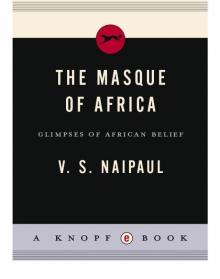 The Masque of Africa: Glimpses of African Belief
The Masque of Africa: Glimpses of African Belief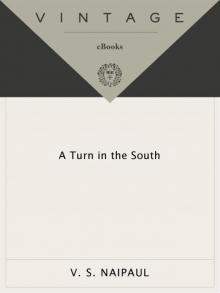 A Turn in the South
A Turn in the South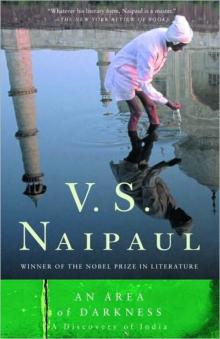 An Area of Darkness
An Area of Darkness Literary Occasions: Essays
Literary Occasions: Essays A Way in the World
A Way in the World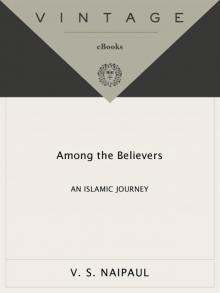 Among the Believers: An Islamic Journey
Among the Believers: An Islamic Journey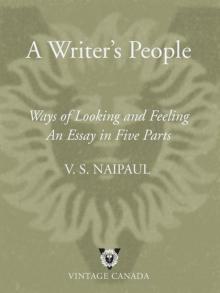 A Writer's People: Ways of Looking and Feeling
A Writer's People: Ways of Looking and Feeling The Mimic Men: A Novel
The Mimic Men: A Novel Collected Short Fiction
Collected Short Fiction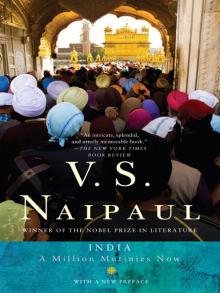 India: A Million Mutinies Now
India: A Million Mutinies Now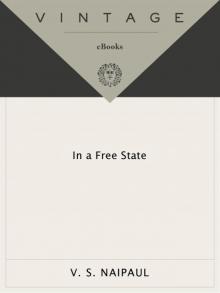 In a Free State
In a Free State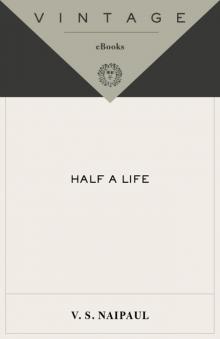 Half a Life
Half a Life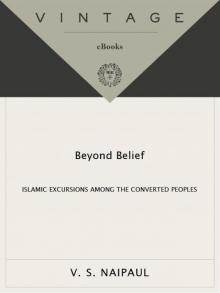 Beyond Belief: Islamic Excursions Among the Converted Peoples
Beyond Belief: Islamic Excursions Among the Converted Peoples Guerrillas
Guerrillas A House for Mr. Biswas
A House for Mr. Biswas The Writer and the World: Essays
The Writer and the World: Essays Magic Seeds
Magic Seeds The Mystic Masseur
The Mystic Masseur Miguel Street
Miguel Street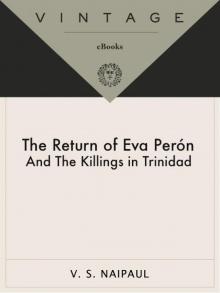 The Return of Eva Perón, With the Killings in Trinidad
The Return of Eva Perón, With the Killings in Trinidad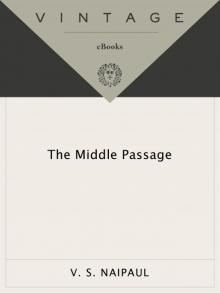 The Middle Passage
The Middle Passage A Bend in the River
A Bend in the River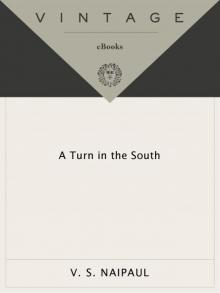 A Turn in the South (Vintage International)
A Turn in the South (Vintage International)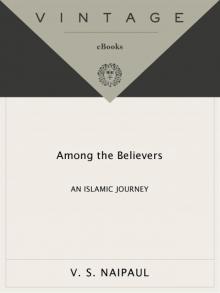 Among the Believers
Among the Believers Literary Occasions
Literary Occasions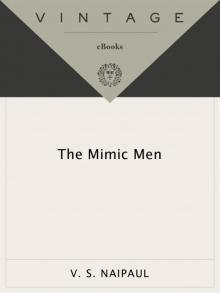 The Mimic Men
The Mimic Men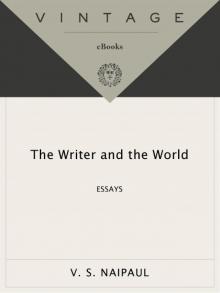 The Writer and the World
The Writer and the World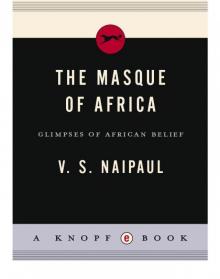 The Masque of Africa
The Masque of Africa